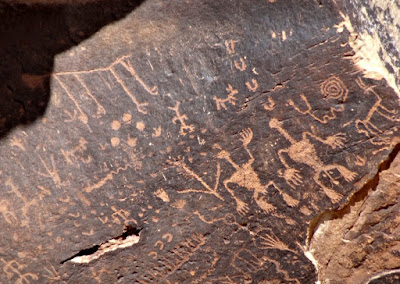Joani booked us for a week at the Sun Valley RV Park in Sun Valley, AZ, just 17 miles west of Petrified Forest National Park so we will have several opportunities to visit the park. Today we wanted to just get acquainted with the park, so all we planned was a leisurely drive through from end to end.
The landscape of the Painted Desert was amazing - so much color in the hills! It reminded us of the Badlands National Monument in South Dakota. Of course, South Dakota did not have beautiful petrified wood strewn about everywhere. One thing we quickly realized was that the colors would be enhanced early in the morning or near sunset. Unfortunately, the park is locked up from 7:00 pm until 7:00 am, so at this time of year we will not be able to see either. Still, we will time our next trip to be the first in line when they open.
The Painted Desert Inn blends in with its surroundings so well it is hard to spot (upper left corner).
The Painted Desert is 7,500 square mile of badlands. Very little of it is accessible by car. The Petrified Forest NP winds through a corner of it with many overlooks along the way.
The north end of Petrified Forest National Park is more about the Painted Desert than petrified wood. Herbert Lore built the Painted Desert Inn using petrified wood in 1920 (then called the "Tree House"), but later it was reconstructed by the CCC in the1930s. Fred Harvey took over management of the property in the 1940s and brought it back to life with a remodel by Mary Colter.
Some of the petrified wood from the original "Tree House" was left visible by the CCC (exterior wall next to Tap Room entrance).
The movie, Grapes of Wrath, included scenes from the Painted Desert Inn.
Myrl Walker, the Petrified Forest National Monument's (PFNM) first naturalist, found this mountain lion petroglyph in 1934 on the east side of Blue Mesa. (PFNM became a National Park in 1962.)
When Mary Colter did the renovations for Fred Harvey in 1948, she hired Hopi artist Fred Kabotie to paint murals throughout the inn that reflected Hopi culture.
The Artist-in-Residence for May of 2017 was James B. Leach, III from Alaska.
A 1932 Studebaker stands as a reminder that Route 66 once passed through the park. All that remains are the telephone polls that lined the road.
Puerco Pueblo can be seen on an easy 0.3-mile loop trail. It is a complex with over 100 rooms surrounding a central plaza built with sandstone and mud mortar. The walls would have been finished with plaster. It was built between A.D. 1250 and 1380 by ancestral Puebloan people.
Petroglyphs can be found along the trail. The oldest here was estimated to be 4000 years old.
The Park researchers have identified over a dozen calendar petroglyph sites marking the changing seasons.
This was the north end entrance station in 1935 (closed in the 1960s). It has gone through several transformations (once housed restrooms in the 1980s) but is now a beautifully restored information station.
Blue Mesa has a 1-mile loop hike that will wait for another day (now that we know that dogs can go on any trail in the park.)
This is the Jasper Forest overlook. The further south you travel, the more abundant the petrified wood becomes.
The visitors center at the south end of the park has some of the more colorful specimens that can be viewed very close up. (Just don't pick anything up!)

























No comments:
Post a Comment